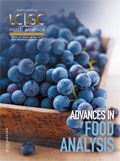Advances in Food Analysis: Introduction from Guest Editor
Special Issues
Food provides the body with energy and good food is indispensable for a healthy life.
Food provides the body with energy and good food is indispensable for a healthy life. With a worldwide population of over seven billion people, it is clear that state-of-the art technology is needed to provide food of a sufficient high quality. Analytical chemistry plays a key role in this. Food quality and safety can only be assured through numerous analyses performed throughout the whole chain from agriculture to the kitchen. Modern analysis tools have made our foods safer, healthier, and better tasting than ever before. As food-analytical scientists, however, we cannot afford to relax. What are state-of-art methods today, will be outdated and insufficient tomorrow. Innovation in food analysis has to continue. And thanks to the never-ending enthusiasm of researchers in the field we can confidently say it does!

Hans-Gerd Janssen
Chromatography and mass spectrometry (MS) are the key mature analytical techniques in modern food analysis. Mature here refers to reliable, with proven performance and good characteristics. Mature should in no way be interpreted as dull, with no new developments! The way we perform MS today for example is very different from 10 to 15 years ago. In the past the mass spectrometer could only be used by true experts, nowadays it is a very powerful detector in the hands of those properly trained. In chromatography we have also seen the introduction and rapid market acceptance of hydrophilic interaction chromatography (HILIC), comprehensive two-dimensional chromatography, and advanced methods for sample preparation. "Direct analysis in real time" (DART), -omics techniques, multi-residue methods, accurate mass MS, and many other methods have found rapid acceptance. It is true that the area of food analysis is not always the first area to develop novel methods, but we are masters in adopting and adapting methods from, for example, the pharmaceutical and biomedical fields. In the future we will continue the inclusion of new techniques into our analytical toolbox. The analysis of natural toxins, for example, requires new methods. In addition, the trend towards less processing, meaning that fewer possible contaminants are removed from products, will have consequences for our work. We are also confronted with regulations that are becoming ever more stringent. The pressure of time is an additional complicating factor. With the food area highly dynamic, we need to come up with solutions now, not in a couple of years.
The world of food analysis is an expanding one. Knowledge from the past remains relevant, while simultaneously new ideas and understanding need to be developed. In this special supplement for LCGC North America, key state-of-the art areas in food analysis are discussed and the applicability of these novel developments are demonstrated.
In the first article the current status of carbohydrate analysis is reviewed. The impact of recent developments on the way classical sugar analysis is performed is discussed and novel strategies for the identification of polysaccharides are described.
Scientists from the RIKILT Institute for Food Safety discuss the trend of miniaturization and multi-compound detection. Smaller particles allow faster separations and reduced flow rates improve the compatibility of liquid phase separation techniques with MS. High-resolution MS allows us to distinguish compounds that are not chromatographically resolved.
Despite the strong developments in MS, separation is still needed. For extremely complex samples, such as citrus essential oils, even the most powerful one-dimensional methods do not provide sufficient resolution. For volatile compounds, comprehensive GC×GC–MS is a valuable approach, as is convincingly demonstrated by scientists from the University of Messina.
Flavor, and especially off-flavor analysis, is an important research field in food analysis. It requires the joint deployment of an array of sensorial and analytical methods, as is described in a contribution by Kathy Ridgeway from Reading Scientific Services Ltd.
With all the novel methods being developed, the toolbox of the food analyst is ever expanding and the selection of the most appropriate method becomes increasingly difficult. Scientists from my team at Unilever have tackled this issue by moving towards more generic methods. Target analysis of several groups of compounds in edible oils and fats can now be done using one, tuneable method.
Finally, we return to complex vegetable sample analysis. For the non-volatile species, comprehensive LC×LC–MS is a good choice, as is discussed in another contribution from scientists at the University of Messina.
We hope the short articles and reviews presented here provide the reader with more background information and provide ideas for the challenging questions of today and the many new questions that will arise in the future.
Hans-Gerd Janssen Unilever Research and Development

Analytical Challenges in Measuring Migration from Food Contact Materials
November 2nd 2015Food contact materials contain low molecular weight additives and processing aids which can migrate into foods leading to trace levels of contamination. Food safety is ensured through regulations, comprising compositional controls and migration limits, which present a significant analytical challenge to the food industry to ensure compliance and demonstrate due diligence. Of the various analytical approaches, LC-MS/MS has proved to be an essential tool in monitoring migration of target compounds into foods, and more sophisticated approaches such as LC-high resolution MS (Orbitrap) are being increasingly used for untargeted analysis to monitor non-intentionally added substances. This podcast will provide an overview to this area, illustrated with various applications showing current approaches being employed.









